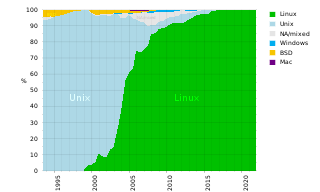
Compute Node Kernel (CNK) is the node level operating system for the IBM Blue Gene series of supercomputers. [1] [2]

Compute Node Kernel (CNK) is the node level operating system for the IBM Blue Gene series of supercomputers. [1] [2]
The compute nodes of the IBM Blue Gene family of supercomputers run CNK, a lightweight kernel that runs on each node and supports one application running for one user on that node. To maximize operating efficiency, the design of CNK was kept simple and minimal. It was implemented in about 5,000 lines of C++ code. [1] Physical memory is statically mapped and the CNK neither needs nor provides scheduling or context switching, given that at each point it runs one application for one user. [1] By not allowing virtual memory or multi-tasking, the design of CNK aimed to devote as many cycles as possible to application processing. [2] CNK does not even implement file input/output (I/O) on the compute node, but delegates that to dedicated I/O nodes. [2]
The I/O nodes of the Blue Gene supercomputers run a different operating system: INK (I/O Node Kernel). [2] INK is based on a modified Linux kernel.

An operating system (OS) is system software that manages computer hardware and software resources, and provides common services for computer programs.

A supercomputer is a computer with a high level of performance as compared to a general-purpose computer. The performance of a supercomputer is commonly measured in floating-point operations per second (FLOPS) instead of million instructions per second (MIPS). Since 2017, there have existed supercomputers which can perform over 1017 FLOPS (a hundred quadrillion FLOPS, 100 petaFLOPS or 100 PFLOPS). For comparison, a desktop computer has performance in the range of hundreds of gigaFLOPS (1011) to tens of teraFLOPS (1013). Since November 2017, all of the world's fastest 500 supercomputers run on Linux-based operating systems. Additional research is being conducted in the United States, the European Union, Taiwan, Japan, and China to build faster, more powerful and technologically superior exascale supercomputers.

A Beowulf cluster is a computer cluster of what are normally identical, commodity-grade computers networked into a small local area network with libraries and programs installed which allow processing to be shared among them. The result is a high-performance parallel computing cluster from inexpensive personal computer hardware.

Blue Gene is an IBM project aimed at designing supercomputers that can reach operating speeds in the petaFLOPS (PFLOPS) range, with low power consumption.
Kerrighed is an open source single-system image (SSI) cluster software project. The project started in October 1998 at the Paris research group The French National Institute for Research in Computer Science and Control. From 2006 to 2011, the project was mainly developed by Kerlabs. In January, 2012 the Linux clustering mission of Kerlabs was adopted by a new company: We Cluster, Inc. headquartered in Pacific Grove, California. January 18, 2012: Kerrighed 3.0 has been ported to Ubuntu 12.04 with Linux Kernel v3.2.

ASCI Red was the first computer built under the Accelerated Strategic Computing Initiative (ASCI), the supercomputing initiative of the United States government created to help the maintenance of the United States nuclear arsenal after the 1992 moratorium on nuclear testing.
SUNMOS is an operating system jointly developed by Sandia National Laboratories and the Computer Science Department at the University of New Mexico. The goal of the project, started in 1991, is to develop a highly portable, yet efficient, operating system for massively parallel-distributed memory systems.

EPCC, formerly the Edinburgh Parallel Computing Centre, is a supercomputing centre based at the University of Edinburgh. Since its foundation in 1990, its stated mission has been to accelerate the effective exploitation of novel computing throughout industry, academia and commerce.
The Parallel Virtual File System (PVFS) is an open-source parallel file system. A parallel file system is a type of distributed file system that distributes file data across multiple servers and provides for concurrent access by multiple tasks of a parallel application. PVFS was designed for use in large scale cluster computing. PVFS focuses on high performance access to large data sets. It consists of a server process and a client library, both of which are written entirely of user-level code. A Linux kernel module and pvfs-client process allow the file system to be mounted and used with standard utilities. The client library provides for high performance access via the message passing interface (MPI). PVFS is being jointly developed between The Parallel Architecture Research Laboratory at Clemson University and the Mathematics and Computer Science Division at Argonne National Laboratory, and the Ohio Supercomputer Center. PVFS development has been funded by NASA Goddard Space Flight Center, The DOE Office of Science Advanced Scientific Computing Research program, NSF PACI and HECURA programs, and other government and private agencies. PVFS is now known as OrangeFS in its newest development branch.
The QCDOC is a supercomputer technology focusing on using relatively cheap low power processing elements to produce a massively parallel machine. The machine is custom-made to solve small but extremely demanding problems in the fields of quantum physics.

A computer cluster is a set of computers that work together so that they can be viewed as a single system. Unlike grid computers, computer clusters have each node set to perform the same task, controlled and scheduled by software.

IBM Sequoia was a petascale Blue Gene/Q supercomputer constructed by IBM for the National Nuclear Security Administration as part of the Advanced Simulation and Computing Program (ASC). It was delivered to the Lawrence Livermore National Laboratory (LLNL) in 2011 and was fully deployed in June 2012. Sequoia was dismantled in 2020, its last position on the top500.org list was #22 in the November 2019 list.
A lightweight kernel (LWK) operating system is one used in a large computer with many processor cores, termed a parallel computer.
New York Blue Gene supercomputer, also known as NewYorkBlue, is an 18 rack Blue Gene/L and a 2 rack Blue Gene/P massively parallel supercomputer based on the IBM system-on-chip technology. It is located in the New York Center for Computational Sciences (NYCCS). The supercomputer is owned by Stony Brook University and is located at Brookhaven National Laboratory in Upton, Long Island, New York. The funds for this machine were provided by the New York state, with the leadership of the NYS Assembly. It began operating on July 15, 2007, when it was the fifth most powerful supercomputer. The renovation of laboratory space was supported by the New York state and U.S. DOE fund. As of June 2010, the Blue Gene/L was ranked 67th in the Top 500 supercomputing rankings. Together with the Computational Center for Nanotechnology Innovations at Rensselaer Polytechnic Institute, NewYorkBlue provides New York state with more computing power available for general research than any state in the nation.

The Slurm Workload Manager, formerly known as Simple Linux Utility for Resource Management (SLURM), or simply Slurm, is a free and open-source job scheduler for Linux and Unix-like kernels, used by many of the world's supercomputers and computer clusters.

Approaches to supercomputer architecture have taken dramatic turns since the earliest systems were introduced in the 1960s. Early supercomputer architectures pioneered by Seymour Cray relied on compact innovative designs and local parallelism to achieve superior computational peak performance. However, in time the demand for increased computational power ushered in the age of massively parallel systems.

Catamount is an operating system for supercomputers.

A supercomputer operating system is an operating system intended for supercomputers. Since the end of the 20th century, supercomputer operating systems have undergone major transformations, as fundamental changes have occurred in supercomputer architecture. While early operating systems were custom tailored to each supercomputer to gain speed, the trend has been moving away from in-house operating systems and toward some form of Linux, with it running all the supercomputers on the TOP500 list in November 2017. In 2021, top 10 computers run for instance Red Hat Enterprise Linux (RHEL), or some variant of it or other Linux distribution e.g. Ubuntu.

INK is the operating system that runs on the input output nodes of the IBM Blue Gene supercomputer. INK is a Linux-derivative.

Fermi is a 2.097 petaFLOPS supercomputer located at CINECA.